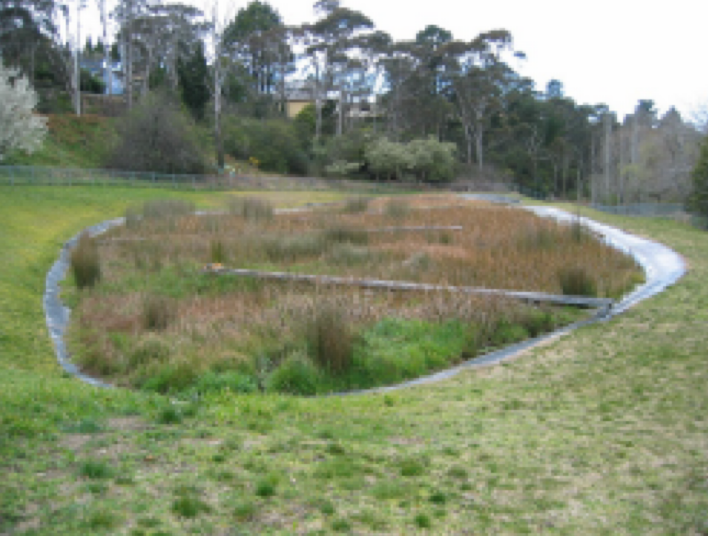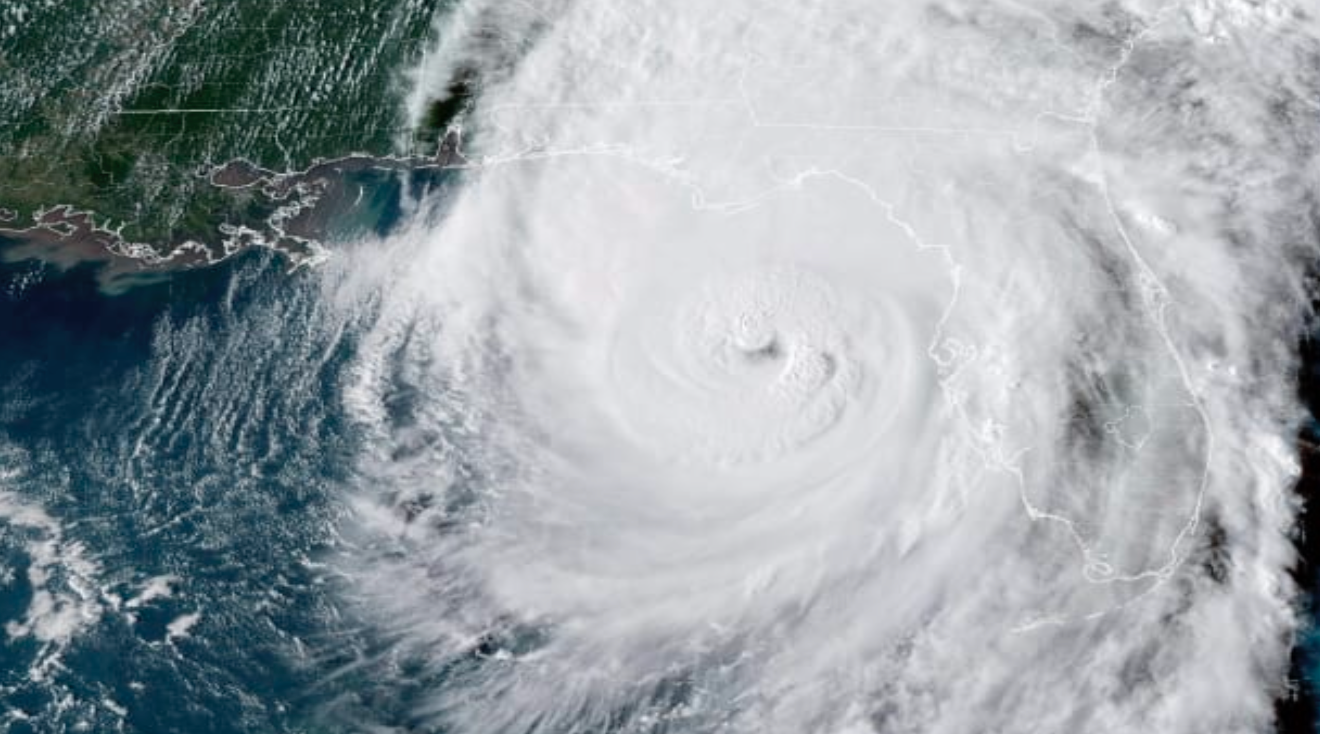BMP Stormwater Wetland

Introduction
Stormwater wetlands (or constructed wetlands) are structural post-construction stormwater controls similar to wet ponds whose design incorporates shallow zones and vegetation. As stormwater flows through the wetland, it removes pollutants through settling and biological uptake. Wetlands are among the most effective post construction stormwater controls in terms of pollutant removal while also offering aesthetic and habitat value. Stormwater wetlands are fundamentally different from natural wetland systems. They are designed specifically to treat stormwater and typically have less biodiversity than natural wetlands in terms of both plant and animal life. Several variations of stormwater wetlands exist, differing in relative amounts of dry, shallow and deepwater zones. Planners need to distinguish between using a constructed wetland for stormwater management as opposed to diverting stormwater into a natural wetland avoiding the latter. Altering the hydrology of a natural wetland can change and degrade the existing system.
Considerations
It's difficult to design stormwater controls with permanent pools. Stormwater wetlands are shallow, so large portions of them are subject to evaporation. This makes maintaining the permanent pool in wetlands more challenging than maintaining the pool of a wet pond. Additional difficulty arises when using stormwater wetlands in urban environments because of the large continuous land area they require. They will work in an urban environment if a relatively large area is available downstream of a site.
Stormwater hot spots are areas where certain land uses or related activities generate highly contaminated stormwater, with higher-than-usual pollutant concentrations. Typical examples include gas stations and industrial areas.
Wetlands can accept stormwater discharge from hot spots but, they need significant separation from groundwater. If designers use these practices to develop wildlife habitat, they should be careful to ensure that pollutants in stormwater discharge do not enter the food chain for organisms living in or near the wetland.
Stormwater Retrofit
A stormwater retrofit is a structural stormwater control that a community puts into place after development to improve water quality, protect downstream channels, reduce flooding or meet other specific objectives. When designers retrofit an entire watershed, stormwater wetlands have the advantage of providing both educational and habitat value. One disadvantage of stormwater wetlands is the difficulty of storing large amounts of stormwater without taking up a large amount of land. It is also possible to incorporate wetland elements, such as enhanced littoral zones (i.e., nearshore and shallow environments) and wetland plantings.
Siting and Design Considerations
Designers need to consider site-specific conditions: drainage area, slope, soils/topography and groundwater and incorporate design features that improve the longevity and performance, minimizing maintenance needs.
Drainage Area
A stormwater wetland needs enough drainage area to maintain a permanent pool. In humid regions, the drainage area needed is typically about 5 to 25 acres, but regions with less rainfall may need a larger area. In some instances, such as in areas with high water tables or regularly high rainfall, smaller systems can be feasible. However, they generally should undergo thorough hydrologic analysis to show that the practice will be viable.
Slope
Sites with an upstream slope of up to about 15 percent can use stormwater wetlands. However, the local slope should be relatively shallow to maintain permanent pool volumes. Construction on steeper slopes is possible through use of a step-pool system.
Soils/Topography
Almost all soils and geology can support stormwater wetlands, with minor design adjustments for regions of karst (i.e., limestone) topography. Designers can include liners for soils with high infiltration rates if water loss is a concern.
Groundwater
Similar to natural wetlands, constructed wetlands often have direct contact with shallow groundwater tables, unless hot spots or excessive infiltration concerns necessitate preventing such contact. This contact generally minimizes infiltration losses and maintains saturation during periods of low rainfall. In extreme cases where groundwater inflow is large relative to surface water area, the shorter detention time can reduce pollutant removal. Groundwater infiltration can decrease the temperature of the water flowing through the wetland, thereby reducing the biological activity that contributes to pollutant removal.
However, groundwater flows are typically small, and the benefit to wetland hydrology is far greater than any reductions in pollutant removal efficiency.
Design Considerations
Specific designs may vary considerably, depending on site constraints or the preferences of the designer or community. Most constructed wetlands, however, should incorporate certain design features. These fall into five basic categories: pretreatment, treatment, conveyance, maintenance reduction and landscaping.
Pretreatment
Pretreatment features remove coarse sediment particles by settling. By removing these particles from stormwater before they reach the treatment area, pretreatment reduces the maintenance burden of the wetland. A wetland typically pretreats using a sediment forebay: a small pool, usually about 10 percent of the volume of the permanent pool. Coarse particles stay trapped in the forebay, and crews perform maintenance on this smaller pool, eliminating the need to dredge and replant the entire treatment area.
Treatment
Treatment The treatment area, or permanent pool, helps a stormwater wetland remove pollutants by increasing the detention time of stormwater within the wetland. Some typical design features include the following: ν The surface area of stormwater wetlands should make up at least 1 percent of the area draining to the practice. ν Wetlands should have a length-to-width ratio of at least 1.5:1. Making the wetland longer than it is wide ensures that water entering the wetland receives adequate treatment. ν An effective wetland design displays “complex microtopography”—underwater earth berms creating both very shallow (<6 inches) and moderately shallow (<18 inches) water zones. This design provides a longer flow path through the wetland that encourages settling and biological pollutant removal processes. It also promotes greater biological diversity, allowing a range of microbial and vegetation communities to flourish, which tends to increase both health and pollutant removal performance.
intermittent flooding/drying cycles can promote mosquito breeding through predator reduction (e.g., mosquitofish, insects and amphibians) during cycles. Designs that incorporate a permanent pool and more stable hydrologic conditions are better able to maintain these predator communities, as well as more biological diversity in general, which helps promote better wetland health and function. Conveyance A stormwater wetland should convey stormwater safely and in a manner that minimizes erosion potential. Designers should always stabilize the wetland’s outfall to prevent scour as well as possibly providing an emergency spillway to safely convey water from large storms. Where thermal pollution is a concern, designers should provide shade around the channel at the wetland outlet.
Maintenance
One potential maintenance concern in wetlands is clogging of the outlet. A wetland should have a non-clogging outlet such as a reverse-slope pipe or a weir outlet with a trash rack. A reverse-slope pipe draws from below the permanent pool, extending in a reverse angle up to the riser, and establishes the water elevation of the permanent pool.
Because these outlets draw water from below the permanent pool, floating debris is less likely to clog them. In addition, no orifice should be narrower than 3 inches, smaller orifices are susceptible to clogging. Another feature that can help reduce the potential for clogging is a small pool, or “micropool,” at the outlet. (Note that these pools can become mosquito breeding grounds and nuisances if in populated areas such as neighborhoods or community parks.) Designers should also incorporate features that ease maintenance of both the forebay and the main treatment area of the wetland. Wetlands should have maintenance access to the forebay, and the treatment area should have a drain to draw down the water for the more infrequent dredging or vegetation harvesting.
Landscaping
Landscaping is an integral part of wetland design—of beautifying wetlands, making them an asset to a community, and enhancing their pollutant removal. To ensure the establishment and survival of wetland plants, a landscaping plan should provide detailed information about the selected plants, a timeline of when they will be planted, and a strategy for maintaining them. The landscape plan should also detail all plants used from within the water all the way up to the upland area.
Establishing plants in the stormwater wetland is key. The most effective techniques include using nursery stock as dormant rhizomes, live potted plants and bare rootstock. Designers can use a “wetland mulch” soil from a natural wetland or a designed “wetland mix” to supplement wetland plantings or establish wetland vegetation. Wetland mulch carries the seed bank from the original wetland and can help enhance diversity. The least expensive option is to allow the wetland to colonize itself, but this takes time and creates the potential for invasive species colonization. When developing a plan for wetland planting, designers and construction staff need to take care to establish plants at the proper depth and during the planting season. The planting season varies regionally and is generally between 2 and 3 months long in the spring to early summer. Plant lists are available for various regions of the United States through wetland nurseries, extension services and conservation districts. Designers should use native plants wherever possible.
Design Variations
Wetland designs can vary in terms of volume of the wetland in the deep pool, high marsh and low marsh, and in whether the design allows for detention of small storms above the wetland surface. Other design variations help to make wetland designs practical in cold climates. Shallow Wetland In the shallow wetland design, most of the volume is in the relatively shallow high marsh or low marsh depths. The only deep portions of the shallow wetland design are the forebay and micropool. This design generally requires less excavation and lower costs, and it is very effective at maximizing vegetation cover. Because the pool is very shallow, though, this design typically needs a large amount of land to store the water quality volume (i.e., the volume of stormwater the wetland will treat). Also, this system type may not be suitable where thermal impacts to cold water streams are a concern.
Extended Detention Wetland
The extended detention wetland design is the same as the shallow wetland, with additional storage above the marsh surface. Stormwater stays in this extended detention zone for between 12 and 24 hours.
This design can treat a greater volume of stormwater in a smaller space than the shallow wetland design. When choosing it, designers should select plants that can tolerate wet and dry periods for the extended detention zone.
Pond/Wetland System
The pond/wetland system combines the wet pond (see Wet Ponds fact sheet) design with a shallow marsh. Stormwater flows through the wet pond and into the shallow marsh. Like the extended detention wetland, this design needs less surface area than the shallow marsh because it stores some water in the relatively deep (i.e., 6 to 8 feet) pond. Pocket Wetland In this design, the bottom of the wetland intersects with the groundwater, which helps to maintain the permanent pool. This option is helpful when the drainage area is not large enough to maintain a permanent pool. Subsurface Flow Wetlands In the subsurface flow wetland design, stormwater flows through a rock or gravel filter (also known as the medium) with wetland plants at the surface. Biological activity and pollutant uptake by plants removes the pollutants. This practice is fundamentally different from other wetland designs because subsurface wetlands are more similar to filtering systems, while most wetland designs behave like wet ponds with differences in grading and landscaping. With a surface layer of mulch for insulation, sub-surface wetlands are also better suited to cold climates where freezing is a concern.
Stormwater Reuse Wetland
Stormwater can be a valuable water resource, helping to offset the use of potable water in water-scarce regions. Stormwater wetlands can harvest and partially treat stormwater for non-potable uses such as irrigation. In this case, designers should perform a water balance analysis to account for the water that users will take from the wetland and make sure the wetland will not dry out. When done correctly, this planned withdrawal can even improve wetland inundation characteristics and vegetation survival.
Limitations
- Features of stormwater wetlands that may make designs challenging and limit their usage include the following:
- Stormwater wetlands consume a relatively large amount of space.
- Stormwater wetlands can become a breeding area for mosquitoes without proper design and maintenance.
- Stormwater wetlands need careful design and planning to ensure that it’s vegetation survives.
- Stormwater wetlands may release nutrients during the non-growing season when plants break down.
- Designers need to ensure that wetlands do not harm natural wetlands or forested areas during the design phase. Maintenance Considerations Though design features can minimize their maintenance needs, wetlands still need regular maintenance and inspection.
Regular maintenance activities for wetlands:
Activity Schedule
Inspect vegetation during establishment or restoration. Biweekly
Until vegetation is established Inspect all components for cracking,
subsidence, spalling, erosion and sedimentation and repair as necessary. Annually
Inspect components that receive or trap debris, and clean/remove debris. Semiannually
Inspect vegetated areas for erosion, scour and unwanted growth. Annually
Replace wetland vegetation to maintain at least 50% surface area coverage
in wetland plants after the second growing season. As needed
Inspect wetland for invasive vegetation and remove where possible. Semiannually
Mow side slopes. 3 to 4 times/year Harvest wetland plants that sediment
buildup has “choked out.” Annually (as needed)
Remove sediment from the forebay when the wetland has lost 50% of its
total forebay capacity. As needed
Monitor sediment accumulations and remove sediment when it has
reduced the pool volume by 50%, when it has “choked” the plants, or
when the wetland has become eutrophic. As needed
Effectiveness
Structural stormwater management, in general, is a way to pursue four broad resource protection goals: flood control, channel protection, groundwater recharge and pollutant removal. Stormwater wetlands can meet all four of these goals, as described below.
Flood Control
One objective of stormwater controls can be to reduce the flood hazard associated with large storms by reducing peak flow from these storms. Designers can easily design a wetland for flood control by providing flood storage above the level of the permanent pool.
Channel Protection
One result of urbanization is the landscape/geomorphic changes—such as eroded stream channels—that occur in response to modified hydrology. Traditionally, stormwater wetlands have provided control of the 2-year storm for channel protection. However, it appears that this control has been relatively ineffective for channel protection, and research suggests that control of a smaller storm, such as the 1-year storm, might be more appropriate. Most current regulations therefore require that channel protection features provide control of the 1-year storm event.
Groundwater Recharge
Stormwater wetlands can only provide groundwater recharge in limited cases, and in soils with high infiltration rates. Generally, the buildup of debris at the bottom of the wetland limits infiltration rates.
Pollutant Removal
Stormwater wetlands are among the most effective stormwater controls for pollutant removal. Table 2 summarizes pollutant removal data from a database of stormwater practice performance (Clary et al., 2017). Designers can also reasonably predict a stormwater wetland’s pollutant removal performance using standard design details. One widely used method, based on an analysis of hundreds of operational stormwater wetlands, is Kadlec and Wallace’s (2009) P-k-C model.
Typical pollutant removal rates of stormwater wetlands.
Pollutant Influent Concentration (Median) Effluent Concentration (Median)
Total copper (µg/L) 4.51 3.20
Total zinc (µg/L) 22.6 12.00
Total suspended solids (mg/L) 38.9 12.0
Total nitrogen (mg/L) 1.50 1.31
Nitrate (mg/L) 0.45 0.22
Total phosphorus (mg/L) 0.18 0.10
E.coli (mp number/100 mL) 780 17
Cost Considerations
Wetlands are a relatively inexpensive stormwater control. Although total costs depend on several factors, including engineering, permitting, construction and maintenance, general equations exist to provide rough estimates. Using construction costs from 84 wetlands ranging from 0.1 to 25,000 acres, Kadlec and Wallace (2009) developed the following equation:
C = 479A0.69 where: C = cost (in thousands of dollars) a = wetland area (acres)
Using this equation, construction costs (in 2019 dollars) for a 1-acre facility would be $600,000, while a 10-acre facility would cost $3 million.
It has been suggested that total initial costs (including pre-construction costs of siting, design, permitting, etc.) per acre of treated impervious surface are $27,000 for new construction and $71,000 for retrofit projects, with pre-construction costs representing 30 to 50 percent of construction costs.
Wetland design should also consider land acquisition and maintenance costs. Stormwater wetlands consume about 3 to 5 percent of the land that drains to them, which is relatively high compared to other stormwater controls. The cost of land is therefore an important consideration.
Maintenance costs for wetlands are similar to those for wet ponds, though they can be slightly higher due to routine maintenance associated with greater vegetation cover or piping infrastructure.
It has been estimated the annual cost of routine maintenance to be roughly $1,000 per acre per year for surface flow wetlands and $1,500 per acre per year for subsurface wetlands. These estimates may show bias toward larger systems. However, King and Hagan (2011) suggest annual maintenance to be around $500 per acre of impervious surface treated. Alternatively, a community can estimate the cost of the maintenance activities outlined in the maintenance section.
Stormwater wetlands typically last longer than 20 years: a community can consider its initial investment in light of this long-life span.



